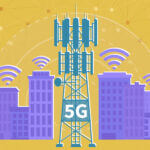
As COVID-19 has forced the world to adopt new strategies for virtual communication, connectivity services have become even more critical. Governments around the world are scrambling to respond to unprecedented internet usage and have asked streaming companies like Netflix and YouTube to reduce streaming quality to deal with the load. As telcos and cloud companies quickly adjust, 5G may save the day, promising greater transmission capacity as more of the world moves online.
In the US, the race to 5G intensified as the merger between T-Mobile and Sprint was finally cleared and officially announced on April 1. While the three telecommunications providers (Verizon, AT&T, and T-Mobile) continue to roll out 5G infrastructure in key cities and announce 5G-enabled phones with Samsung and LG, the three cloud players also stepped into the race, announcing partnerships to enable 5G edge computing.
AWS Wavelength
The marketing-leading cloud giant, Amazon Web Services (AWS), pulled the early trigger announcing a partnership with Verizon at AWS re:Invent in December 2019. AWS Wavelength provides AWS Infrastructure to Wavelength Zones (telecommunication provider’s edge datacenter with 5G network) to allow developers to build applications with low-latency requirements.
Early applications point to streaming and gaming Applications as AWS and Verizon announced initial pilots with the NFL and Bethesda Game Studios. Any IoT Applications requiring low latency and high bandwidth, notably manufacturing and other industrial IoT, may benefit from AWS Wavelength. Smart cities can also extend streaming and video applications beyond stadiums and conference centers if a data center exists nearby. AWS seems to be pushing more onto the edge and on-prem as AWS Wavelength follows AWS Outposts and Local Zones offerings on top of a series of edge capabilities for AWS IoT services.
Anthos for Telecom
Google Cloud responded in March by announcing Anthos for Telecom and more importantly Global Mobile Edge Cloud (GMEC). Anthos for Telecom follows Google’s focus on leveraging its expertise in Kubernetes to build hybrid cloud applications using its container management service. GMEC provides AWS Local Zones-like service by opening up Google’s global data centers and edge locations for telcos to run low latency applications.
The initial announcement came with a partnership with AT&T, highlighting retail, manufacturing, and gaming Applications. Since Thomas Kurian took over the helm at Google Cloud, the focus shifted to maximizing Google’s core advantages in a container (Kubernetes) and machine learning expertise in specific verticals. While Google Cloud still trails AWS and Azure in terms of cloud market share, it may hold some key advantages in the 5G network edge space. The obvious one is connecting Android developers with other telcos to co-develop new experiences that require 5G connectivity (perhaps next generation of AR/VR applications). The other is integrating Stadia (Google’s cloud gaming platform) and game server services to unlock even more gaming applications to utilize both cloud and edge networks.
Azure Edge Zones
Microsoft soon followed suit with the announcement of Azure Edge Zones and a partnership with AT&T in late March. It also announced Azure Private Edge Zones for private 5G and LTE network Applications utilizing Azure technology on private edge data centers. Microsoft went onto announce a $1.35 billion acquisition of virtualized mobile network company Affirmed Networks. Given Affirmed Networks’s prior relationship with AT&T, Orange, and Vodafone, Microsoft can accelerate its entrance into the 5G race.
The official announcement highlighted online gaming, remote meeting, and smart infrastructure as the three initial Applications for Azure Edge Zones. The growth of Microsoft Teams and the existing user base for Xbox Live may be the selling point for companies looking to utilize Azure’s new offering. On the Private Edge Zones front, Microsoft mentioned smart factory, logistics, and medicine as the three key scenarios.
Race to 5G
So far, the media attention on the race to 5G primarily focused on commercial applications and network infrastructure. With all three cloud players jumping into the race, enterprise and IoT applications may soon unlock more opportunities for low latency and high throughput Applications aside from online gaming commonly associated with 5G.





 New Episode
New Episode





 Latest IoT News
Latest IoT News










